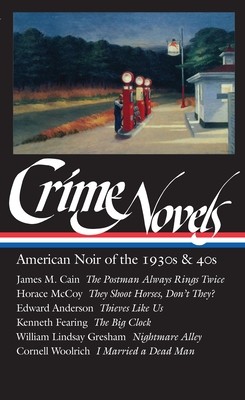
- We will send in 10–14 business days.
- Publisher: Library of America
- Year: 1997
- Pages: 990
- ISBN-10: 1883011469
- ISBN-13: 9781883011468
- Format: 13.5 x 20.8 x 3.3 cm, kieti viršeliai
- Language: English
- SAVE -10% with code: EXTRA
Crime Novels: American Noir of the 1930s & 40s (Loa #94) (e-book) (used book) | bookbook.eu
Reviews
Description
"The most important collection of crime fiction ever published in the United States." -- Ed Gorman
Evolving out of the terse and violent style of the pulp magazines, noir fiction expanded over the decades into a varied, innovative and profoundly influential body of writing. The eleven novels in The Library of America's adventurous two-volume collection taps deep roots in the American literary imagination, exploring themes of crime, guilt, deception, obsessive passion, murder, and the disintegrating psyche. With visionary and often subversive force they create a dark and violent mythology out of the most commonplace elements of modern life. James M. Cain's pioneering novel of murder and adultery along the California highway, The Postman Always Rings Twice (1934), shocked contemporaries with its laconic toughness and fierce sexuality. Horace McCoy's They Shoot Horses, Don't They? (1935) uses truncated rhythms and a unique narrative structure to turn its account of a Hollywood dance marathon into an unforgettable evocation of social chaos and personal desperation. In Thieves Like Us (1937), Edward Anderson vividly brings to life the dusty roads and back-country hideouts where a fugitive band of Oklahoma outlaws plays out its destiny. The Big Clock (1946), an ingenious novel of pursuit and evasion by the poet Kenneth Fearing, is set by contrast in the dense and neurotic inner world of a giant publishing corporation under the thumb of a warped and ultimately murderous chief executive. William Lindsay Gresham's controversial Nightmare Alley (1946), a ferocious psychological portrait of a charismatic carnival hustler, creates an unforgettable atmosphere of duplicity, corruption, and self-destruction.I Married a Dead Man (1948), a tale of switched identity set in the anxious suburbs, is perhaps the most striking novel of Cornell Woolrich, who found in the techniques of the gothic thriller the means to express an overpowering sense of personal doom. Disturbing, poetic, anarchic, punctuated by terrifying bursts of rage and paranoia and powerfully evocative of the lost and desperate sidestreets of American life, these are underground classics now made widely and permanently available. LIBRARY OF AMERICA is an independent nonprofit cultural organization founded in 1979 to preserve our nation's literary heritage by publishing, and keeping permanently in print, America's best and most significant writing. The Library of America series includes more than 300 volumes to date, authoritative editions that average 1,000 pages in length, feature cloth covers, sewn bindings, and ribbon markers, and are printed on premium acid-free paper that will last for centuries.
EXTRA 10 % discount with code: EXTRA
The promotion ends in 23d.08:40:57
The discount code is valid when purchasing from 10 €. Discounts do not stack.
- Publisher: Library of America
- Year: 1997
- Pages: 990
- ISBN-10: 1883011469
- ISBN-13: 9781883011468
- Format: 13.5 x 20.8 x 3.3 cm, kieti viršeliai
- Language: English English
"The most important collection of crime fiction ever published in the United States." -- Ed Gorman
Evolving out of the terse and violent style of the pulp magazines, noir fiction expanded over the decades into a varied, innovative and profoundly influential body of writing. The eleven novels in The Library of America's adventurous two-volume collection taps deep roots in the American literary imagination, exploring themes of crime, guilt, deception, obsessive passion, murder, and the disintegrating psyche. With visionary and often subversive force they create a dark and violent mythology out of the most commonplace elements of modern life. James M. Cain's pioneering novel of murder and adultery along the California highway, The Postman Always Rings Twice (1934), shocked contemporaries with its laconic toughness and fierce sexuality. Horace McCoy's They Shoot Horses, Don't They? (1935) uses truncated rhythms and a unique narrative structure to turn its account of a Hollywood dance marathon into an unforgettable evocation of social chaos and personal desperation. In Thieves Like Us (1937), Edward Anderson vividly brings to life the dusty roads and back-country hideouts where a fugitive band of Oklahoma outlaws plays out its destiny. The Big Clock (1946), an ingenious novel of pursuit and evasion by the poet Kenneth Fearing, is set by contrast in the dense and neurotic inner world of a giant publishing corporation under the thumb of a warped and ultimately murderous chief executive. William Lindsay Gresham's controversial Nightmare Alley (1946), a ferocious psychological portrait of a charismatic carnival hustler, creates an unforgettable atmosphere of duplicity, corruption, and self-destruction.I Married a Dead Man (1948), a tale of switched identity set in the anxious suburbs, is perhaps the most striking novel of Cornell Woolrich, who found in the techniques of the gothic thriller the means to express an overpowering sense of personal doom. Disturbing, poetic, anarchic, punctuated by terrifying bursts of rage and paranoia and powerfully evocative of the lost and desperate sidestreets of American life, these are underground classics now made widely and permanently available. LIBRARY OF AMERICA is an independent nonprofit cultural organization founded in 1979 to preserve our nation's literary heritage by publishing, and keeping permanently in print, America's best and most significant writing. The Library of America series includes more than 300 volumes to date, authoritative editions that average 1,000 pages in length, feature cloth covers, sewn bindings, and ribbon markers, and are printed on premium acid-free paper that will last for centuries.


Reviews